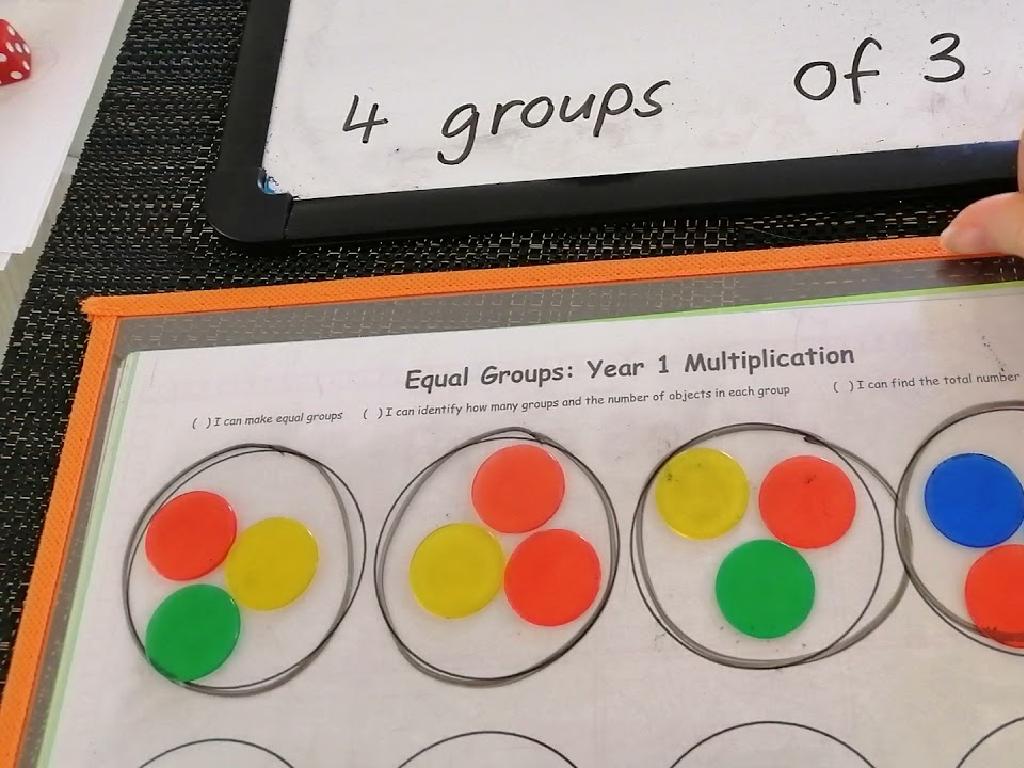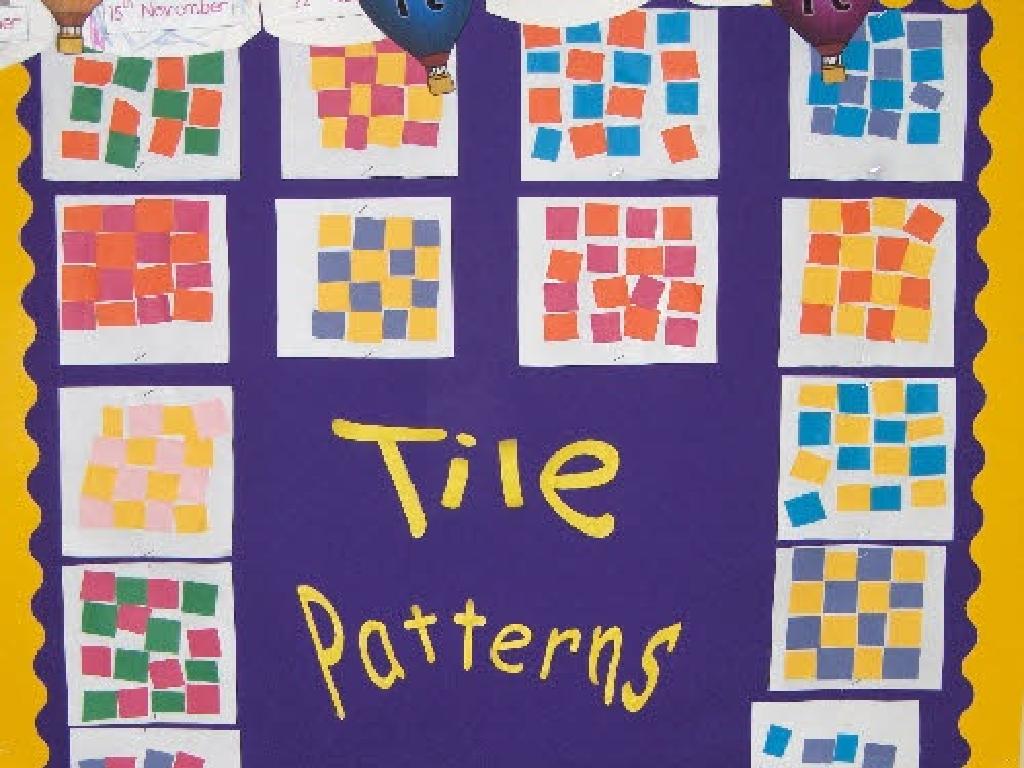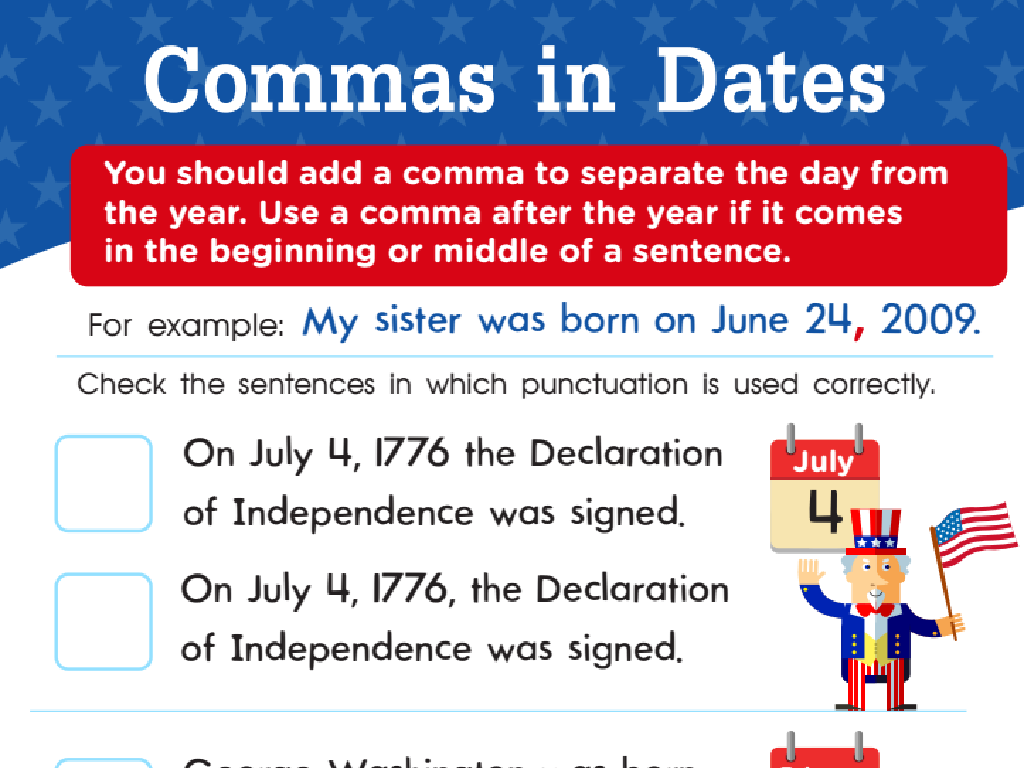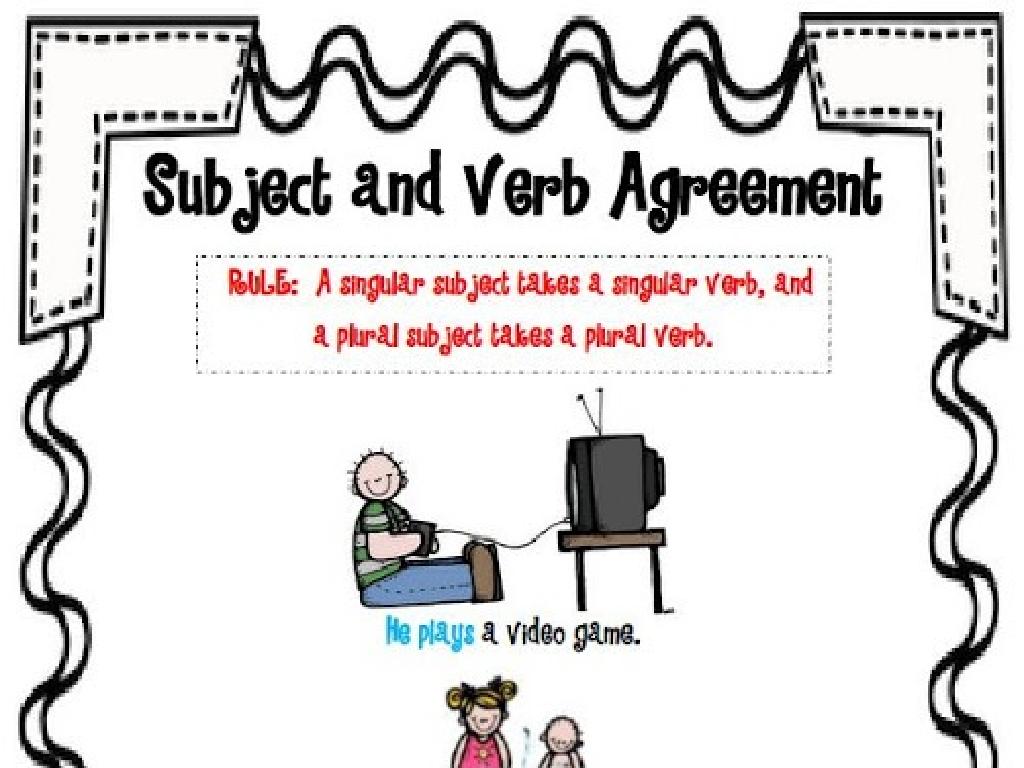Find What Percent One Number Is Of Another: Word Problems
Subject: Math
Grade: Sixth grade
Topic: Percents Of Numbers
Please LOG IN to download the presentation. Access is available to registered users only.
View More Content
Welcome to Percents!
– Understanding the concept of percents
– A percent represents a part out of 100, like 25% is 25 out of 100.
– Percents in daily life
– Examples: sales tax, discounts, and statistics.
– Percents, fractions, and decimals
– 50% is 1/2 and 0.50, showing the connection between these forms.
– Practice with real-world problems
|
This slide introduces students to the concept of percents and their relevance in everyday situations. Begin by explaining that a percent is a way of expressing a number as a fraction of 100. Show how percents are used in various daily life scenarios, such as calculating sales tax or determining discounts during shopping. Highlight the relationship between percents, fractions, and decimals to help students convert between them, which is a crucial skill in many real-world applications. Provide examples and encourage students to think of other situations where they encounter percents. The goal is to ensure students understand percents conceptually and can apply this knowledge to solve word problems.
Understanding Percents
– Percent means ‘per hundred’
– 1% equals 1 out of 100
– Relation: Percents, fractions, decimals
– 50% is 1/2 or 0.5; 25% is 1/4 or 0.25
– Applying percents in problems
– If a shirt costs $20 and is 25% off, what’s the new price?
|
This slide introduces the concept of percent to the students, explaining that the term ‘percent’ refers to the parts per hundred. It’s crucial to show that 1% is the same as 1 out of 100, which can be a stepping stone to understanding larger percentages. Highlight the relationship between percents, fractions, and decimals, as this will be important for converting between them in various math problems. Provide examples to illustrate these conversions. Finally, apply this knowledge to real-world problems, such as calculating discounts, to make the concept more tangible for the students. Encourage them to think of percents as another way to express fractions and decimals, and use everyday examples like shopping discounts to practice.
Calculating Percentages in Word Problems
– Identify ‘whole’ and ‘part’
– Determine which number is the total amount and which is a portion
– Apply the percentage formula
– Use Percent = (Part/Whole) x 100 to find the percentage
– Convert to a percent
– Multiply the result by 100 to get a percentage value
– Practice with examples
– Solve example problems to reinforce the concept
|
This slide introduces students to the concept of finding the percentage of a number through word problems. Start by explaining how to identify the ‘whole’ (the total amount) and the ‘part’ (a portion of the total) in a given problem. Then, demonstrate the formula Percent = (Part/Whole) x 100, ensuring students understand each component. After calculating the decimal result, teach them to convert it into a percent by multiplying by 100. Provide several example problems for students to practice, such as finding the percentage of students who have dogs if 15 out of 30 students in the class have dogs. This hands-on practice will help solidify their understanding of percentages in real-world contexts.
Word Problems: Deciphering the Percent Puzzle
– Carefully read the problem
– Highlight key information
– Look for numbers, words like ‘total’, ‘all’, ‘percent of’, and other clues
– Determine what to find: part, whole, or percent
– Is the question asking for a piece of the total, the entire amount, or the percentage?
– Use a problem-solving strategy
– Strategies like drawing a diagram or writing an equation can help
|
This slide is aimed at teaching students a systematic approach to solving word problems involving percentages. Start by reading the problem thoroughly to understand what is being asked. Students should be encouraged to highlight or underline numbers and key phrases that indicate whether the problem is asking for the part, the whole, or the percent. Emphasize the importance of identifying exactly what needs to be found to answer the question correctly. Introduce problem-solving strategies such as visual representation or forming an equation to organize their thoughts and calculations. Provide examples and practice problems to reinforce these steps and build confidence in tackling percent word problems.
Calculating Percentages in Word Problems
– Identify the ‘part’ and ‘whole’
– Part: 8 boys, Whole: 20 students
– Convert to fraction: part/whole
– Fraction of boys: 8/20
– Multiply by 100 to find percent
– To get percent, multiply by 100
– Example: 8 boys out of 20 students
– (8/20)*100 = 40% of the class are boys
|
This slide introduces students to the concept of finding percentages through a relatable classroom example. Start by defining ‘part’ as the number of boys and ‘whole’ as the total number of students. Show how to convert this relationship into a fraction (8/20), and then into a percentage by multiplying by 100. This results in 40%, which is the percentage of boys in the class. Emphasize the importance of understanding the terms ‘part’ and ‘whole’ in percentage problems. Encourage students to practice with different numbers and scenarios to solidify their understanding.
Calculating Discounts with Percents
– Identify the percent value
– The percent given is 25%
– Determine the whole amount
– The original price, which is $40, is the whole
– Calculate the discount
– 25% of $40 is calculated as (25/100) x 40 = $10
– Understand the savings
– The discount shows how much you save on the purchase
|
This slide presents a word problem to help students understand how to find the percent one number is of another, specifically in the context of calculating discounts. The example provided is a practical application of this concept, where students learn to identify the percentage of the discount and the original price of an item to determine the amount saved. By breaking down the problem into steps, students can see how to convert the percentage to a decimal, multiply it by the whole amount, and find the discount. This exercise not only reinforces their understanding of percentages but also provides a real-world skill that they can use in everyday situations, such as shopping during a sale.
Practice Problems: Percentages
– Solve word problems independently
– Use the learned formula and steps
– Remember: Percent = (Part/Whole) x 100
– Collaborate with a partner if needed
– Share your solutions in class
|
This slide is designed to encourage students to apply their knowledge of percentages to solve word problems. They should attempt the problems individually first, which will help them assess their understanding of the concept. If they struggle, they can work with a partner for collaborative learning. Remind them to use the formula Percent = (Part/Whole) x 100 and the steps we’ve covered in class. After completing the problems, students will have the opportunity to share their solutions, fostering a collaborative and supportive learning environment. For the teacher: Prepare to facilitate the sharing session, ensuring that each student or pair has a chance to present their work. Have additional problems ready for students who finish early or need extra practice.
Class Activity: Percent Scavenger Hunt
– Search for percentage labels
– Calculate part, whole, or percent
– Use the formula part = percent × whole
– Present findings to the class
– Reflect on the activity
– Discuss how percentages are used in everyday items
|
This interactive class activity is designed to help students apply their knowledge of percentages to real-world contexts found within the classroom. Students will search for items that have percentage labels, such as books that advertise ‘20% more content’ or ‘30% off’. They will then use the percentage formula to calculate either the part, whole, or percent, depending on what information is given and what is asked to find. After calculations, students will present their findings to the class, explaining how they arrived at their answers. This will reinforce their understanding and allow for peer learning. As a teacher, prepare to guide them through the formula and provide assistance as needed. Possible activities for different students could include finding percentages in nutrition labels, discount tags, or educational materials. Encourage students to reflect on how percentages appear in everyday objects and their importance.
Wrapping Up: Percents in Word Problems
– Review today’s key concepts
– Homework: Worksheet practice
– Solve more problems to master percents
– Think of questions for next class
– Write down any doubts or difficulties
– Reinforce learning at home
|
As we conclude today’s lesson on finding the percentage one number is of another using word problems, it’s crucial for students to revisit the main points. Encourage them to review the steps for calculating percentages and to understand the real-world applications of this skill. For homework, students should complete the provided worksheet, which contains additional word problems to reinforce their learning. Remind them to bring any questions they have to the next class for clarification. This practice will help solidify their understanding and prepare them for more complex percentage problems in the future.






